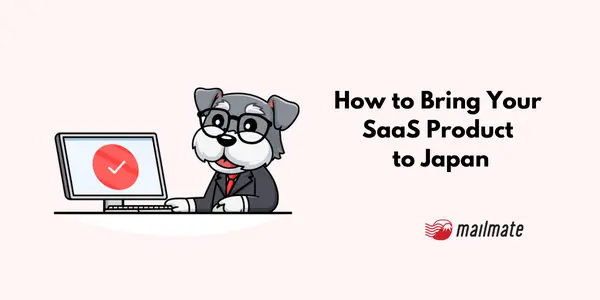How to Bring Your SaaS Product to Japan

Thinking of bringing your software as a service (SaaS) business to Japan?
Perhaps you're wondering how foreign companies manage global expansion to Japan? Or how foreign SaaS companies market themselves to a local audience?
Today, we take a brief look at key concerns when considering entry into Japan's SaaS marketplace from individuals who have had experience with Japan's SaaS industry and selling SaaS products in Japan.
1. Fully remote vs. going local?
There are no particular regulations on selling software in Japan or to a Japanese audience. But the usual incorporation procedures apply for opening either a Kabushiki-Kaisha (KK) or a Godo-Kaisha (GK). Yet, some experts caution against setting up a physical office in Japan, pointing to the financial risks of doing so.
“Opening a Japan office is obviously a significant undertaking and can be a distraction from your core business.
"If you can find native speakers of Japanese in your area and have them join your team, that would be ideal. However, you may want to consider having them on a contract that is somewhat flexible in nature in case you later need to pull out of Japan to save costs. This has happened to several SaaS vendors in times of financial crises. The ones who survived often came back to the Japanese market years later to resume the process.” (Source: “Localizing Your SaaS into Japanese: A Primer,” Xtra)
Instead, they propose you hire freelancers who can understand the Japanese market, speak Japanese, and serve as your proxy in marketing and sales.
Since you are selling a digital product, you won't have warehousing needs. You will be able to operate with a fully remote freelance workforce, keeping costs minimal and pushing investment toward other essentials, such as localization and marketing—the two primary issues facing selling your software in Japan.
Still, if you are creating or have created software that addresses a Japan-specific need, then there's a strong case to incorporate a company here. MakeLeaps co-founder Jay Winder, in a previously published article, discussed his personal entrepreneurial journey in creating and selling an invoice software tool in Japan.
Winder summarizes his experience as follows: “[Much] of what we've learned has only been possible because we're on the ground and able to directly contact and interact with our customers. For a SaaS product targeting the Japanese market, you will absolutely need a team on the ground to get you the information you need for your build/measure/learn cycle. Success in Japan is very rarely achieved accidentally. In our experience, your realistic options are either to build a team in Japan, or to partner with a company in Japan experienced in market entry.”
Whether you establish a company here yourself or hire a remote team that will be your eyes and ears on the ground—building a competent bilingual team will be essential for breaking into the Japan market.
2. Localization and marketing considerations
Understanding the intricacies of SaaS platform architecture is crucial for effectively adapting and scaling your SaaS product to meet the unique needs of the Japanese market.
So, localizing your software development and SaaS product for Japanese audiences will be one of the primary goals you must initially tackle.
The difference between translation and localization is as follows: translation finds an equivalent meaning from one language to the next; localization addresses cultural and non-textual aspects to provide messaging that is meaningful to a local audience.
Machine translations might be sufficient for some aspects of your software as a service. Still, for marketing endeavors that aim to clinch sales—such as advertising, website copy, social media posts, direct sales letters, etc.—you will need to localize to suit Japanese business and consumer needs. Some localization sites to consider are LingoHub and Crowdin.
Marketing is another crucial consideration, and you may wish to hire an agency to help you with running ads or a social media campaign that appeals to Japanese audiences. If you are attempting to remain light on your feet and adhere to Japanese advertisement laws, then consider hiring contractors in the copywriting, graphic design, and marketing fields, selecting those who are bilingual in English and Japanese.
👉 Read about market segmentation in Japan!
Take note: Top-talent contractors who are also bilingual are rare because individuals with English and Japanese fluency get snapped up quickly into full-time positions.
Of course, if you are willing to hire full-time, pay industry-average salaries, and are prepared to incorporate your business in Japan, then your chances of finding and hiring bilingual top talent will further improve. In either case, establishing a strong team in Japan—full time or as contractors—is essential to winning sales and making sure that your service is meeting consumer needs.
An alternative solution to staffing issues is to use a bilingual virtual assistant service as a liaison point between your needs—as you direct from overseas—and your Japanese contractors. This setup will widen your talent pool considerably.
3. Understanding SaaS sales techniques for Japan
“In Japan, due to the long history of custom-made systems, and the existence of a large number of System Integrators who also do contract developments for smaller IT projects, many B2B customers in Japan expect some form of customization to fit their particular needs from SaaS vendors as well,” says Fuminori Gunji, TokyoMate's CEO.
"Decision-making in Japanese companies, especially if it's mid-sized or bigger, is based on a collective decision-making process. For example, say you're sitting across from a person in a room. You might be tempted to think, ‘This is the person who is in charge of the buying decision.' That may appear to be the case based on the company's organization chart, but the truth is, that person then goes back to the company and talks with their bosses and also the employees to reach a common agreement to make that decision. Therefore, even if you convince that person in the meeting room, your sales deal is still far from done. It's not enough to impress only that person in the room.”
Gunji proposes you know and master the following steps for a successful sales call:
Show that you have common sense + that you understand the customer. Make it sound like what you provide is the new de facto standard of the industry because Japanese companies don't want to fall behind.
Show cases of companies in the same industry. And if you can't, create a case study and say, “Here's a user case in a different industry with exactly the same problems that you have."
Find out the KPIs that their company cares about. Help provide the info they need to convince their bosses or subordinates and facilitate the collective decision-making in their company.
Offer to put on a sales demo. Conduct a presentation for the other stakeholders so that everyone gets the most powerful sales pitch directly from you, and not secondhand.
Pick a date for your next sales meeting at the end of each sales meeting. Say, “Let's set up our next meeting where I will come back with the information you need.”
4. Understanding BtoB digital marketing strategies for IT sales
Medix, a company specializing in BtoB digital marketing, conducted a survey of 519 individuals involved in the selection of BtoB IT products and SaaS solutions to Japanese enterprise and medium to small businesses.
The survey targeted those involved in introducing their company's IT products or services within the past year and aimed to understand the sources of information and the types of content used during the decision-making process.
Here are the key points from the survey:
Sources of information change as prospects move through the decision-making process—The survey identified the sources of information used by IT product selectors at different stages of the decision-making process. The most commonly used sources of information during the initial stages were search engines and web media. However, the use of these sources decreased as prospects moved toward the final selection stage, during which the use of vendor or manufacturer websites and sales representatives increased.
Desired information on websites includes case studies and product overviews—The survey also explored what information IT product selectors want to see on websites at different stages of the decision-making process. The most sought-after information across all stages included product/service overview, price, and case studies of implementation. However, the importance of these types of information varied depending on the stage of decision-making.
Smaller companies decide quickly; larger companies take more time—The survey found that the consideration period for product or service adoption varied depending on the size of the company. Smaller companies (10 employees or less) tended to have a shorter consideration period (7-30 days), while larger companies (5,001 employees or more) had a longer consideration period (31-90 days). The number of people involved in the decision-making process also increased with the size of the company.
Understanding where IT product selectors gather information and what information they seek on websites can help in creating more effective BtoB marketing strategies.
Frequently asked questions on SaaS Japan
What are some top SaaS companies in Japan?
There are numerous Japanese SaaS companies, including freee, SmartHR, Money Forward, Treasure Data, etc. These companies offer a variety of back office services, catering to personal and corporate money, business processes, customer data, and more.
How many SaaS startups are there in Japan?
According to Tracxn, there are over 1053 SaaS startups in Japan. These startups offer a range of services, including cloud-based HRMS software solutions.
Can a SaaS startup break into the Japanese market without a physical presence?
Yes, several SaaS companies have successfully entered the Japanese market without a physical presence. This is often achieved through a community-led growth model, hiring remote teams who understand the Japanese market, and focusing on the development, localization and marketing.
What do I need to know to sell SaaS in Japan?
Selling SaaS in Japan requires understanding the local market, localizing your product, and building a competent bilingual team. It's also important to understand that decision-making in Japanese companies is often a collective process, so your sales techniques should cater to this.
What are the top SaaS trends in Japan?
While specific trends can vary, the Japanese SaaS market is expected to be worth ¥1.5 trillion by 2025. Companies are focusing on localization, marketing, and understanding the unique needs and decision-making processes of Japanese businesses.
Final thoughts
Entering the Japanese SaaS market requires a re-evaluation of known SaaS models. Whether you choose to establish a physical presence or operate remotely, it's crucial to understand the local market and adapt your product and marketing strategies accordingly.
Localization is a key aspect of this process, ensuring that your software resonates with Japanese businesses and consumers. Building a competent bilingual team, either in-house or through freelancers, is also essential for effective communication and sales.
Understanding the unique sales techniques and decision-making processes in Japan can significantly improve your chances of success. Staying informed about the latest trends and strategies in BtoB digital marketing for IT sales, as highlighted by the Medix survey, can provide valuable insights for your marketing efforts and long-term success.
As the SaaS market in Japan continues to grow, there are ample opportunities for foreign SaaS companies to succeed. However, it's important to approach this market with a clear understanding of its unique characteristics and a willingness to adapt to its specific needs and expectations.
Spending too long figuring out your Japanese mail?
Virtual mail + translation services start at 3800 per month. 30-day money-back guarantee.

